The Port Authority Trans-Hudson Railroad, or the PATH train, is NYC’s “other” subway, running under 6th Avenue, Christopher Street, Greenwich Street and Morton Street and from Church Street at the World Trade Center site to various stops in Hoboken, Jersey City, and Newark, New Jersey. At its full length, it runs from one block away from NYC’s Pennsylvania Station to Newark’s Penn Station. At a $2.75 fare (now less than the $2.90 NYC subway fare), savvy city riders can save 15 cents traveling from Midtown to Greenwich Village (updated 9/23).
The PATH is the modern-day result of the first attempt to cross the mighty Hudson by placing railroad tracks in a tunnel. Engineer Dewitt Clinton Haskins drove a partial tunnel from the Jersey side beginning as early as 1874 but got only partway before an accident claimed 20 lives. A British firm took up the mantle in 1890, but again was forced to abandon the pursuit.
An ambitious lawyer from Georgia via Tennessee, William Gibbs McAdoo, obtained backing and employed upgraded tunneling methods in 1901, proceeding to do what by then was considered impossible: he engineered multiple tunnels and inaugurated rail service, the first trans-Hudson rail of its kind, between NYC and Hoboken, from 1908-1910 and Jersey City and Newark Park Place in 1911. Newark Penn Station service was added to what was called the Hudson and Manhattan Railroad in 1937. Original service ran between Hoboken and 19th Street (now closed to the general public) and opened February 25, 1908. The H&M was, in effect, the original 6th Avenue Subway — Independent Subway 6th Avenue service did not open until December 15, 1940.
The H&M was, in part, responsible for the old World Trade Center. The railroad had fallen into bankruptcy in the 1950s, but The Port Authority agreed to purchase and maintain the Hudson Tubes in return for the rights to build the World Trade Center on the land occupied by H&M’s Hudson Terminal (the “original” Twin Towers on Church Street), which was the Lower Manhattan terminus of the Tubes.
William Gibbs McAdoo (1863-1941), the son-in-law of U.S. President Woodrow Wilson, acted as Wilson’s Treasury Secretary from 1913 until 1919, raising millions for the US effort in WWI. He unsuccessfully ran twice for the Democratic presidential nomination in 1920 and 1924, and was later elected a US Senator from California in 1933, serving one 6-year term.
Despite the cheaper fare, I confess I haven’t used PATH much over the years. Despite a connection with the 14th, 23rd and 33rd Street stations on 6th Avenue, the subway and PATH are separate entities and no transfers are allowed, though PATH did begin using Metrocards a few years ago. I rode it more in the 1980s and 1990s when my journeys to Hoboken were more frequent — I saw a number of shows at a venue called Maxwells (still going strong) and obtained tickets at a record store (remember them?) on 1st Street called Pier Platters.
I should ride more often. The PATH has its quirks. For one thing there’s a distinctive, musty aroma, that to me is not all that horrible, but I imagine plenty of folks aren’t fond of it. Despite a lot of modernization over the years, most stations do contain some elements of original “19-oughts” construction. Until recently the rolling stock was, in many cases, 1965 vintage. And, despite their proximity, much of Jersey City and Newark remain unplumbed and unexplored territory for your webmaster, with Hoboken slightly less unknown.
Today, I’m concentrating on the PATH in NYC, where it has six stations (the 19th Street station was closed in 1954, the 28th Street station in 1937 when the 33rd Street station was moved south). I found some interesting interactions and leftovers from a previous age. Because PATH actually has a policy prohibiting photography (unlike the MTA), I didn’t do any in-station photography, relying instead on photos from NYCsubway.org (credited where appropriate).
I didn’t photograph the PATH’s WTC station on this trip, but I did so in 2007.
33rd Street
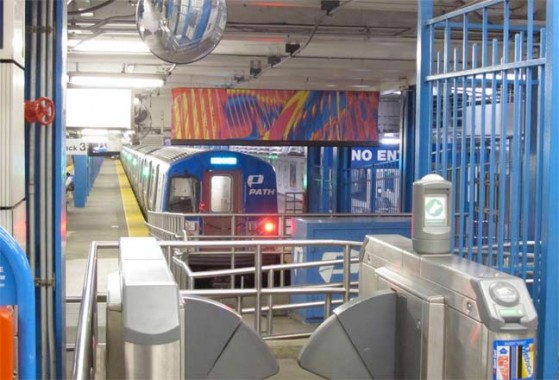
The 33rd Street station is entered (mostly) through the basement of the Manhattan Mall, the former Gimbels on 6th Avenue between West 32nd and 33rd Streets. Like the MTA’s West 4th Street station, there are no longer any exits on 33rd Street proper, as this is the second terminal on the site. While the original opened in November 1910, a new 33rd Street station had to be constructed from 1937-1939 to make way for the Independent Subway complex, which provides connections to the BMT, PATH, and IND lines. photo: NYCsubway.org
On weekdays there are separate routes from here for Hoboken and Jersey City service, which are combined into one route for the overnights and weekends. At all times, transfers may be made at Grove Street in JC for Newark-bound service, which originates at the World Trade Center site.
There is an unused passageway (closed for safety reasons) connecting the IND-BMT-PATH 33rd-34th Street complex with 7th Avenue and Penn Station.
(I should quickly add that the old subway division abbreviations, BMT, IND, IRT, are rapidly falling out of favor with younger riders. The BMT (Brooklyn-Manhattan Transit) consists of a variety of lines constructed in Brooklyn and Manhattan beginning in 1913 and mostly finished by the 1920s; the IND (Independent) Subway was built in 4 boroughs by the city from 1925-1948; and the IRT (Interborough) Subway was NYC’s first subway, opening in 1904 and mostly finished by 1920.)
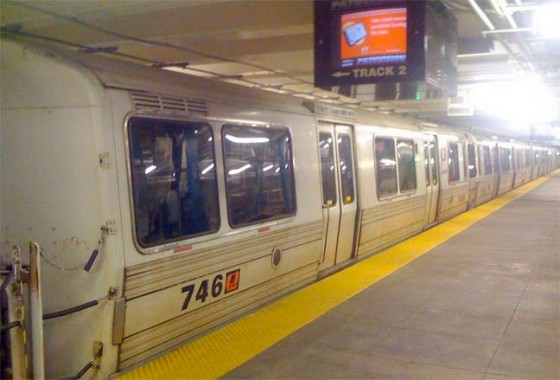
A 1960s-vintage PA-1 car idles at 33rd Street in 2008. Kawasaki PA-5s would replace them beginning in the next year. photo: NYCsubway.org
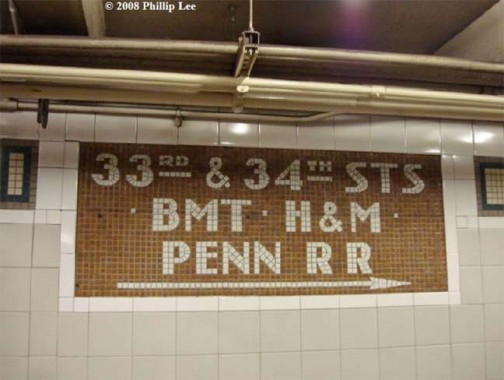
Original tiled IND subway sign in the IND 34th Street station pointing to the PATH terminal. When the IND 6th Avenue Line opened in 1940, PATH was still known as the Hudson & Manhattan, and several directional signs still point riders to the “H&M.” Also at this time, the passageway to Penn Station was still open, and riders didn’t have to brave the rain, cold or heat to walk a block outside to get there. Of course, fewer and fewer riders remember what the BMT was, too! photo: NYCsubway.org

This entrance-exit at 30th and 6th is only open weekdays. It shows off the 1970s? era streamlined station entrances with blue and white Helvetica signs. More recent signs use a different font (see below).
23rd Street
Both IND Subway and PATH 23rd Street stations share entrances and exits. PATH riders descend and then ascend to the tracks as the PATH runs a level below the IND.
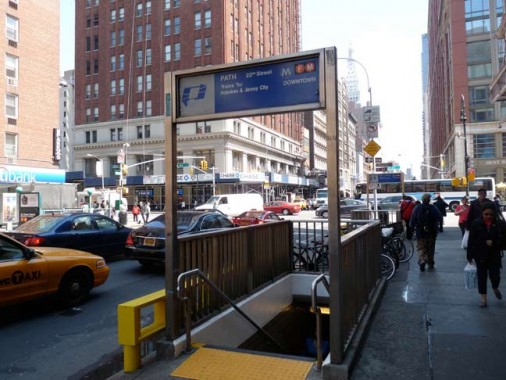
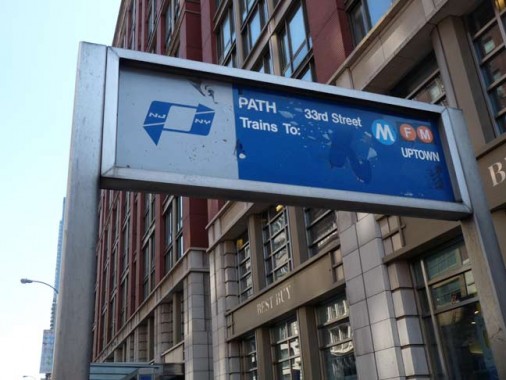
One of the “modern” entrance-exits on the west side of 6th and 23rd. However, the ones on the east side are from a previous generation…
The “big M” is one of the former official MTA logos. It might have tricked people into thinking the M train ran here. In mid-2010, that became a reality as the M was rerouted down 6th Avenue, replacing the old V line.
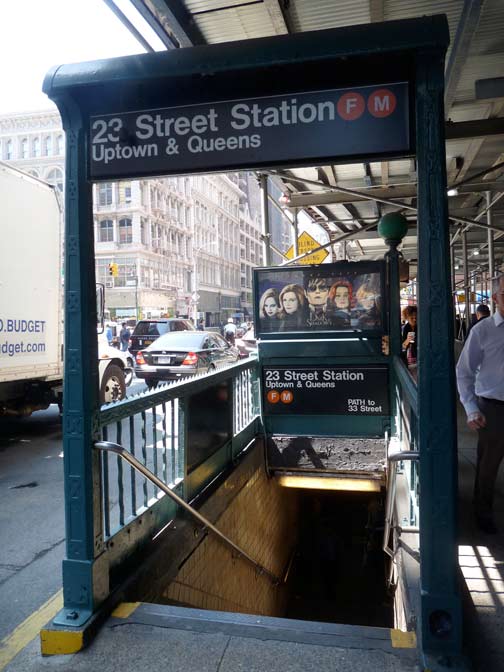

The entrances on the east side are your typical IND entrances with a crosshatching design except that there’s a ‘hood’ stanchion, its underside lit by incandescent bulbs. I don’t have any photos of what these looked like in 1940 when they first appeared, but they were probably there to hold signs proclaiming that the station served both IND and H&M clientele.
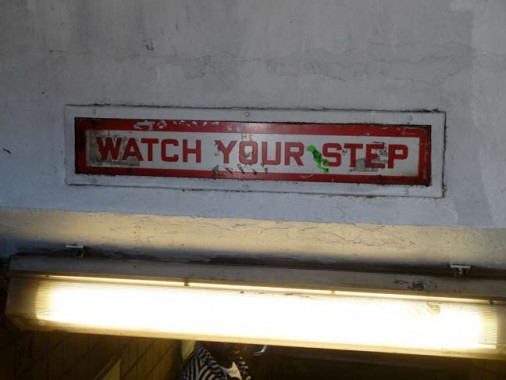
On the northeast corner is a “watch your step” sign that likely goes back to 1940. Otherwise the 23rd Street station is fairly devoid of original signage, which isn’t the case with 14th Street (see below).
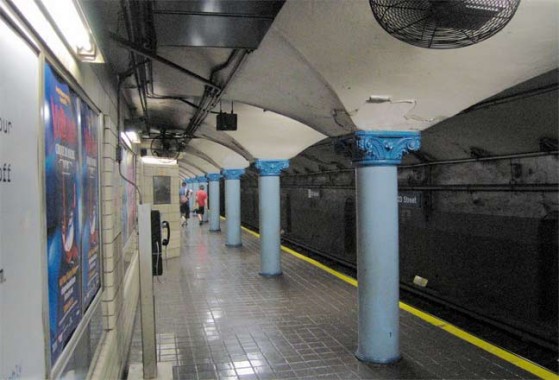
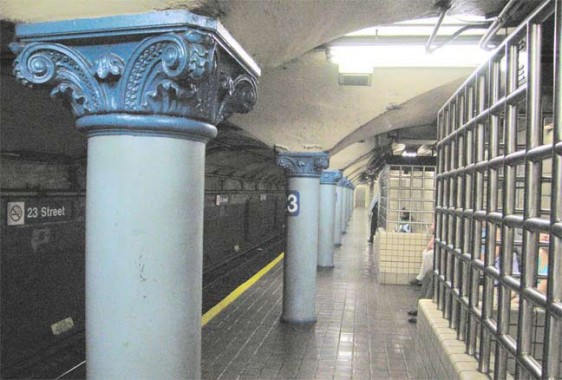
The 23rd Street station platforms have retained a good deal of original Beaux-Arts construction dating to the station’s opening, June 23, 1908. It’s quite reminiscent of the original Heins and Lafarge stations of the 1904 IRT (running on the #6 line from Brooklyn Bridge north). The vaulted ogee curves are H&M trademarks and appear in many of the stations both in Manhattan and New Jersey. photos: NYCsubway.org
14th Street
Where 23rd Street was fairly devoid of old IND/H&M signage, the 14th Street station is a virtual sign museum. This is a surprisingly busy subway interchange, since the station also connects with the 7th Avenue IRT #1, 2, 3 lines via a pedestrian tunnel, and there’s also a subway (though not PATH) transfer to the crosstown BMT L line. Hence, IRT, IND, BMT, PATH all interact here.
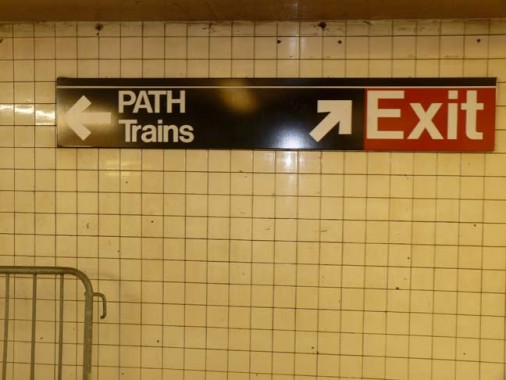
First is a modern-day black and white Helvetica directional sign, pretty much standard since the 1960s. For some time, Exit signs have been red and white.
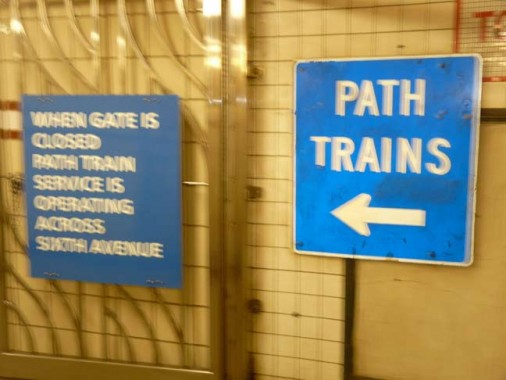
Right next to it, the Port Authority has its own blue and white sign pointing to the connecting pedestrian tunnel.
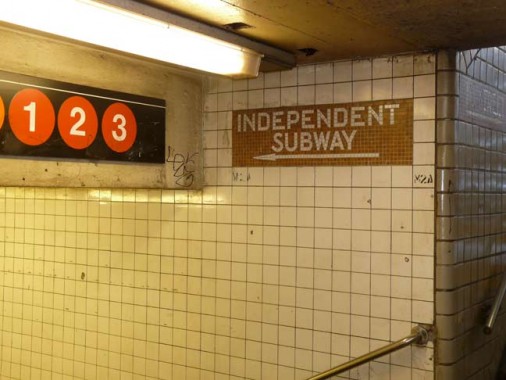
A tiled “Independent Subway” sign leading to the F/M lines. An adjacent pedestrian tunnel goes 1 block under 14th Street to 7th Avenue where you can get the #1, 2, 3.
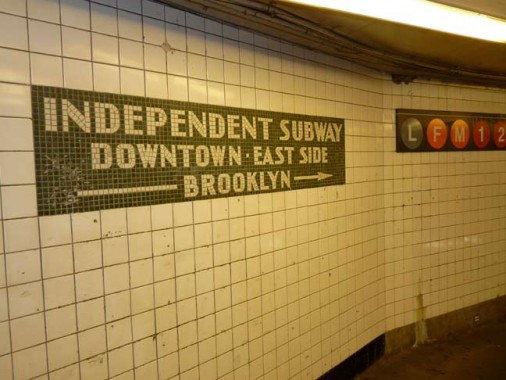
1940-vintage tiled sign. There’s a very ‘serious’ look about the lettering of IND-era signs. Compare to Helvetica, which originated in Switzerland in 1957 — the letters just look ‘friendlier’ or more colloquial. These signs communicate a ‘let’s go to work’ vibe to the subway commuter. The Helvetica signs want to be your pal.
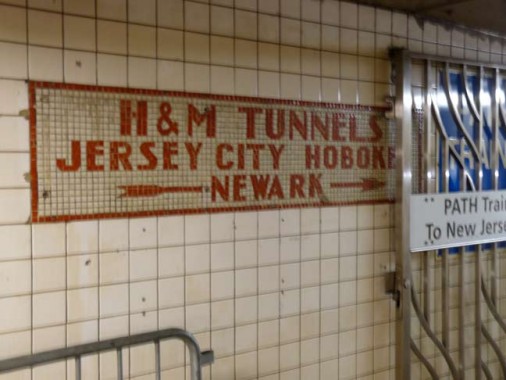
The Independent Subway (IND) helpfully included directional signs to the H&M tunnels. Newark service began in 1937, and these signs were unveiled in 1940. Again, the type is all business, no nonsense here. There was a war on!
On the right is a newer PATH system sign, this time not in the usual Helvetica, but in Frutiger, a font that first appeared in Charles deGaulle Airport in Paris in 1968.
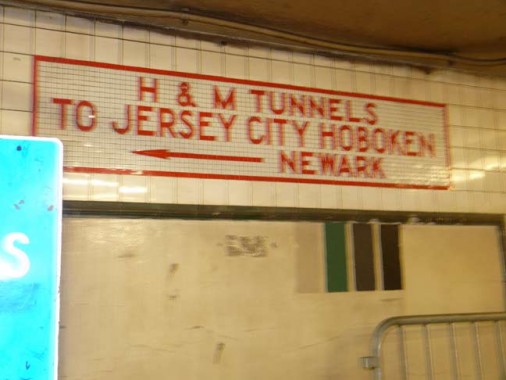
Another H&M sign in a slightly different 1940 font.
Whoever figures out a way to make digital camera photos less fuzzy in dim light, or invents a Photoshop setting to eliminate the fuzz, will be richer than Zuckerberg.
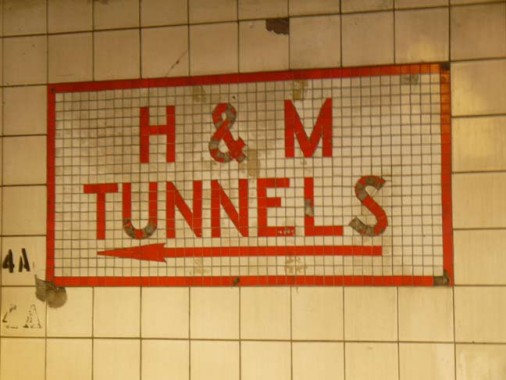
And just so you won’t miss them, here’s one more sign pointing to the H&M tunnels. A good way to spot IND signage is to look at the capital E. The three prongs are all different widths.
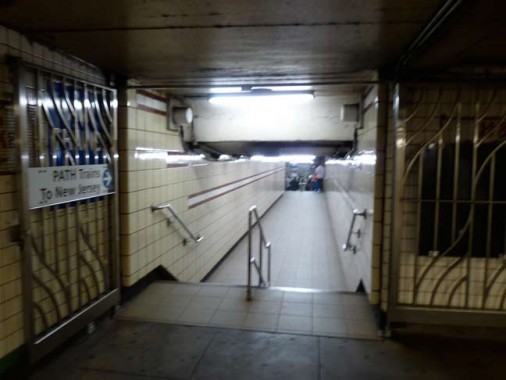
PATH tiling takes over in the connecting tunnel.
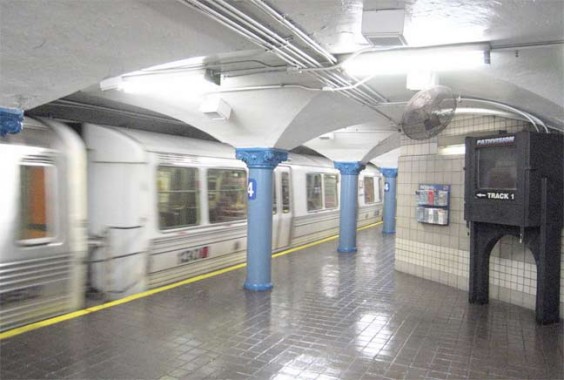
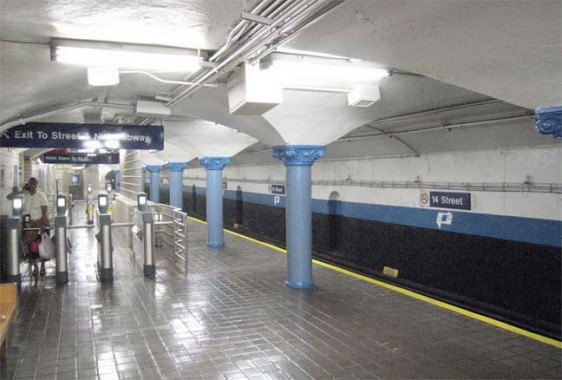
A pair of views from the platform– thoroughly modern in every way, except the vaultings and pillars, which go back to the station opening, February 25, 1908. PATH turnstiles are a little different from the MTA — whereas the MTA uses a swipe system, which even the most seasoned rider sometimes messes up, at Path you insert the card in one slot on the bottom, it registers the fare and pops out a different slot on top. (I hear the MTA wants to do away with Metrocards altogether and charge directly from debit or credit cards, but that’s years away.) Instead of concrete surfacing, PATH stations use a matted surface. photos: NYCsubway.org
Here are two more of the IND’s unique ‘hood’ subway entrance stanchions, which I can’t find anywhere but at 14th and 23rd Streets. In one the incandescent bulbs have been replaced with fluorescents. I have, though, found these on older photos of BMT entrances, so they were once more numerous.
A modern CEMUSA newsstand stands beside the entrance on the NW corner of 6th and 14th.
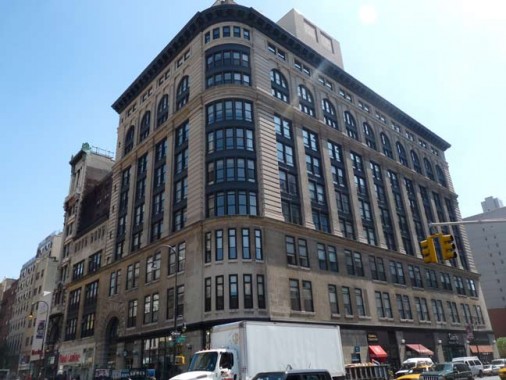
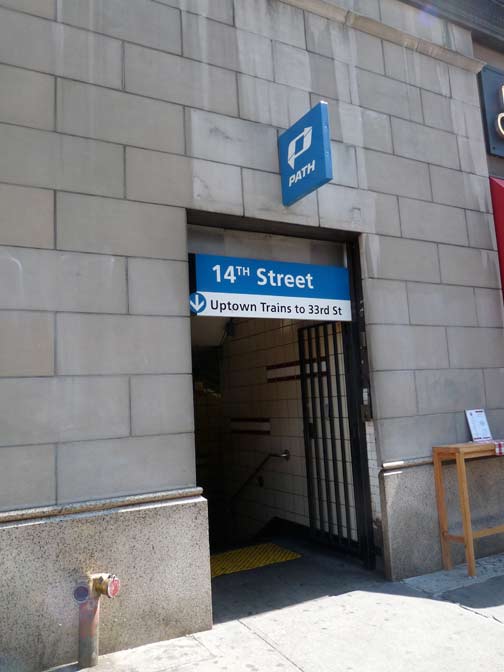
PATH stations are often entered through building basements. The one on the SE corner of 6th and 14th employs one of the newer Frutiger typeface signs. According to Jim Naureckas at Songlines,
This handsome building with arched entrances was built by Henry Siegel, co-creator of the Siegel-Cooper store five blocks north. He sold his interest in the “Big Store” in 1904 to make an even bigger department store in the area vacated by Macy’s–but the new store went bust and Siegel went to jail in 1914 for defrauding creditors.
Next door, and wrapping around to West 13th and 14th, was the former home of Macy’s before it moved uptown to Herald Square in 1902. Red stars, Macy’s symbols, can still be seen on the West 13th side.
9th Street
Here the PATH turns southwest as it prepares to cross the Hudson. On the remaining two Manhattan stations on this PATH branch, there are just one entrance each that lead to a center platform.
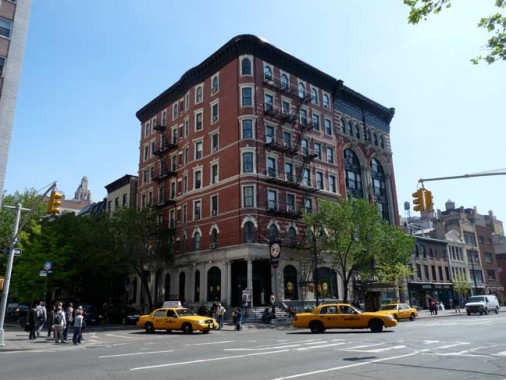
The north side of this building on the SE corner of West 9th and 6th Avenue is seen by PATH passengers when exiting, a 1910s apartment building with side bays and a rounded corner, was home to a nightclub called Trude Heller’s in the 1960s and 1970s:
Back when she was still Goldie Zelkowitz, [Genya] Ravan performed at the club with her first two groups–the vocal/doo-wop-oriented Escorts, and the groundbreaking girls-only Goldie and the Gingerbreads. She describes Heller as an out lesbian with an intimidating “tough cookie” demeanor. “She required rockers to rock—no ballads. She’d go crazy with rage whenever we sang a ballad. I’d look down from the stage and see her getting angry, then she’d run over to the light switch and start flicking it on and off, screaming, “C’mon! C’mon! Let’s twist already! Let’s twist the night away! Come on, baby, let’s do the f**kin’ twist!…All she wanted was action and for the place to rock.” She also required a lot from her performers—Ravan describes a schedule of “six 45-minute sets a night, with half-hour breaks in between.” In addition to running the club, Heller produced/promoted big concerts at other venues (such as the Supremes at Lincoln Center) and started a record label, Tru-Glo-Town Records. With her son Joel, she co-owned another equally wyld club on 8th Street called the Eighth Wonder (as told to the Spectropop yahoogroup by Alan Gordon, songwriter and member of the Magicians. It’s All the Streets You Crossed Not So Long Ago
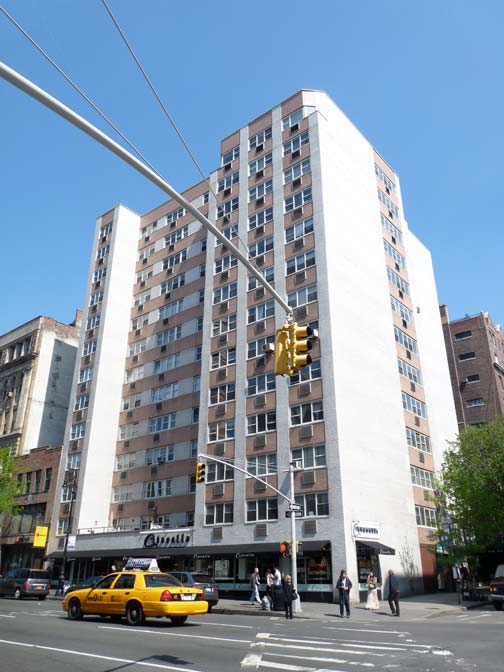
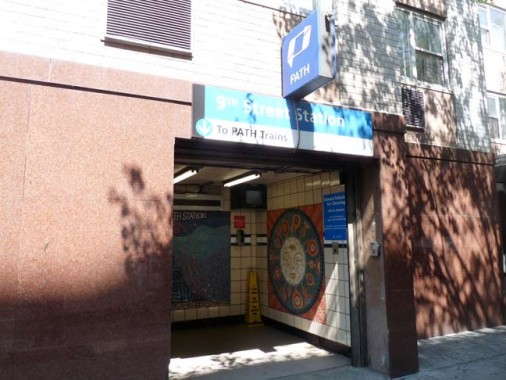
The big white high-rise at the NE corner of 6th and West 9th contains the rather inconspicuous PATH entrance. 69 West 9th was built in 1956; Barbra Streisand lived there briefly in the 1960s.
9th Street has a collection of murals just inside the entrance. (Someone fill me in on the artist).
Though the center platform has been thoroughly modernized, riders can still see the original H&M barrel vaulting on the walls. You also travel through an unusual curved tunnel to get to the platform.
Christopher Street
The Christopher Street PATH entrance, #137 between Hudson and Greenwich, is actually its own freestanding building, constructed in 1912, with a chiseled “Hvdson & Manhattan R.R. Co.” sign at the roofline and a restored iron and glass marquee in front. The AIA Guide to NYC says it’s reminiscent of a London tube station entrance.
The murals lining the staircase (including one resembling a recent vice-presidential candidate, though it’s not meant to be Sarah Palin) are by artist Biff Elrod and were painted on site in August 1986 as a temporary installation for the Public Art Fund.
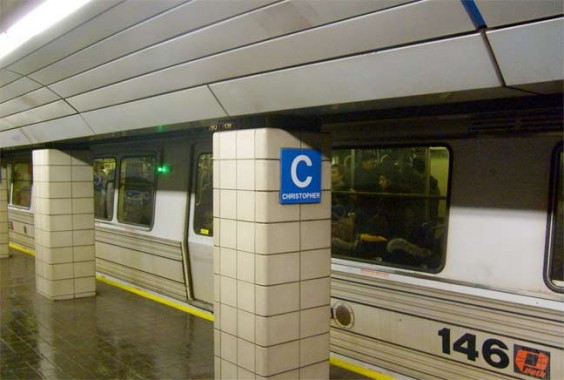
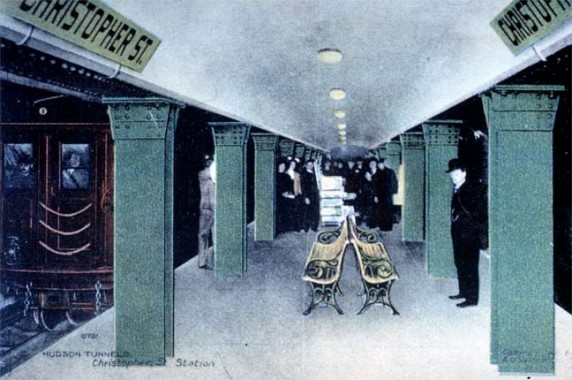
Though there’s not much trace of the original appearance because of modern tiling and signage, I found a postcard from the 19-oughts that shows what it looked like.
The modern signs match the former Chicago practice of showing the station’s initial letter with the station name under it.
For the complete PATH story, consult Brian Cudahy’s “Rails Under the Mighty Hudson,” Fordham University Press 2002.
5/21/12


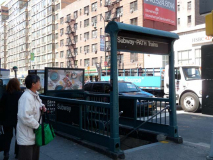
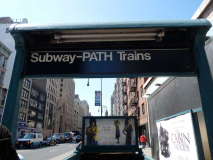
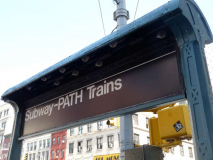
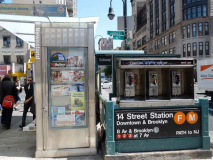
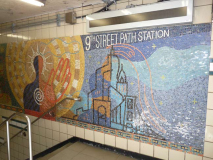
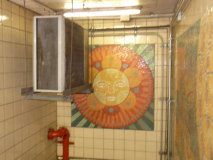
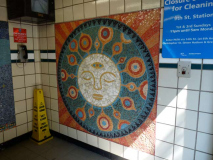
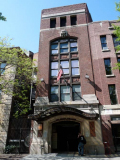
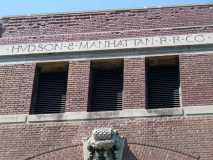
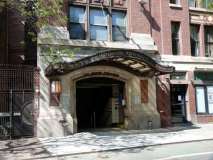

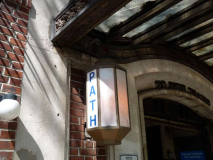
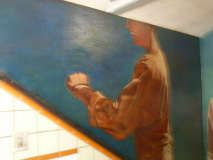
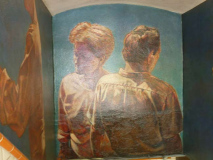
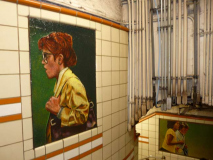
50 comments
“There is a passageway connecting the station to the IRT 7th Avenue Christopher Street station.” Really? Where? And since when?
The wikipedia entry claims there is one, but I’ll remove the reference till I know for sure.
Yes, there is somewhere and it is a really long walk.
It would be lovely if there were such a passageway, but one must actually go up to street level and then walk three blocks east on Christopher Street to get to the IRT.
The passageway was a dank, block-long hike, and kinda scary, since hardly anyone–except maybe me every once in awhile–ever used it. Now hidden behind bricks and tile.
The PATH isn’t actually a subway, it’s a commuter rail line just like Metro North RR, LIRR, SIR, and NJ Transit are. However, the lines and stations already existed before the PANYNJ ran them, they just took over them back in the 1960’s. Compared to the subway platforms, they do look a lot better especially with the columns in them that many of the subway platforms don’t have, which are just steel girders. Before it was renamed the PATH, it was originally the Hudson Tubes. As a matter of fact, the route to 33rd Street almost stopped the TA from building the 6th Avenue line from being built. The WTC stop, which isn’t mentioned here, is the only PATH stop in Manhattan not to connect with the rest, so a whole different route is given for that, plus the current station isn’t the original one, which is about a block east from where the current one is now. My guess was that the PANYNJ saw it as too small and obsolete, which is why the current one is there now. For the record, I only used the PATH once and that was last year when going from Newark-Penn Station to 33rd Street to see the Gay Pride Parade and return for a NY Liberty game, who were playing at the Prudential Center that season, though I returned by taking the PATH at 14th Street when going back to Newark.
I am not really sure why you say that. Websters describes it as a passageway in which pedestrians, trains, etc, pass underground. It is entirely underground in Manhattan and in some parts on NJ.
Just because it happens to be underground, doesn’t make it a subway. There are also parts of the LIRR and Metro North RR that run underground as well, but that doesn’t make it a subway either. I won’t argue with it being a passageway, but that doesn’t make it a subway. The reason I call the PATH a commuter train is because it is one officially, plus it has a schedule of when they stop, which is not the case for actual subways, plus the difference between subways and commuter trains is that subways come much more frequent compared to commuter trains being sporadic. BTW, it’s common for parts of a commuter train line to be underground, and the same goes for others such as BART in San Francisco and SEPTA in Philadelphia or even the RER in Paris. Overall, I call line by what they are officially, and the PATH is officially a commuter train. NYC didn’t get it’s first subway line until 1904, so before then, they only had commuter trains and yes some of them where underground, which predates the subway.
Beg pardon, Tal Barzilai, on several counts.
The first one: “it has a schedule of when they stop, which is not the case for actual subways…” All railroads have schedules, and this includes rapid transit railroads. Unless the basic principles of railroading have changed in the 23 years since I worked there, the New York subways most certainly have timetable schedules.
“the difference between subways and commuter trains is that subways come much more frequent compared to commuter trains being sporadic.” Clearly you haven’t been on the New Haven Line in the rush hour.
The “difference(s) between subways and commuter trains,” as I’ve observed after a lifetime of riding on them and 36 years of working on them, are more often than not due to accidents of history and political lobbying that put different lines on one side or another of Federal railroading laws. The work being done is the same, although the scale in sheer numbers alone is much larger on our local current “subway” lines.
“NYC didn’t get it’s first subway line until 1904, so before then, they only had commuter trains…” By your definition, all the lines that run down to Coney Island, and the lines from East New York to Jamaica and Canarsie, are “commuter trains.”
You really miss the point here, Rodeo95. My point is that the PATH is officially regarded as a commuter rail line despite also being a rapid transit. Just because you can use a Metrocard for it, doesn’t make it a subway either. I won’t argue with you on taking commuter trains during peak hours, but off peak, they aren’t as packed as such. Those lines you mentioned in Brooklyn was part of the Brooklyn Rapid Transit, and was built in the late 1800’s. What makes them different from the Interboro Rapid Transit is that they weren’t originally built by the Transit Authority. However, they were absorbed into the subway system when the companies declared bankruptcy as it became the Brooklyn Manhattan Transit. According to the website of the MTA, the first subway came in 1904 and it’s listed there, so I didn’t make that up. The term commuter trains comes from the fact that these are trains that bring people from the suburbs into the city, and the link explains it all, which I didn’t make up either.
http://en.wikipedia.org/wiki/Commuter_train
you are an idiot. it is a subway.
No, you’re the idiot. Tal Barzilai is correct. The PATH is a commuter railroad.
Each car has to meet FRA (Federal Railroad Administration) standards of a locomotive because it shares trackage in New Jersey between Harrison & Journal Square with other railroads. So they have to meet Federal locomotive collision standards, hand hold standards, glazing standards and be operated by Federally certified railroad engineers instead of motorman.
That’s what makes it a railroad.
The SIR is in the same situation. They share trackage with a railroad so each car has to meet the FRA locomotive standards as well.
Not right, there is no shared trackage between PATH and freight/passenger lines through Jersey City and the Meadowlands. It is a shared RIGHT-OF-WAY. Best place to see this is at Harrison, with the inbound and outbound PATH lines running on either side of the Amtrak/NJ Transit tracks between Penn Newark and Penn NYC. And stop with this idiot stuff.
Some subways do have scheduled service. In fact, outside of New York, most US ones do. Chicago did until about a decade ago, and still does for late night service. I’m pretty sure Boston, LA, DC, Miami all have scheduled service for their metros.
It’s true that PATH originated as a commuter rail road, and that there are a few Federal rules it has to follow because of that. But it is operated like a metro system in most regards and even uses renovated MTA Subway cars for it’s rolling stock. So, in most regards it is an extension of the subway and it’s really a dumb attitude by both the MTA and the Port Authority to not interested fares and fully promote it as part of the subway because insisting on calling it “commuter rail” and comparing it to Metro North, etc, misleads residents and visitors about the potential usefulness of it as part of the New York area transportation options. PATH also has fixed fares, while nearly all true commuter rail system use distance based fares.
BART and RER are also commuter rail system that have some aspects more like subways, but they have equipment that looks very different than the rapid transit in their respective cities and very different fares. DC’s Metro looks a bit like BART, and runs far into the suburbs, so is more like RER or BART in function, but is still considered a Subway or metro-style system.
PATH should be called a subway, both because it is, and because it does potential riders a real disservice to call it something different, distracting them from whether or not it’s a useful part of their New York experience.
You say you’ve ridden PATH before, Tai? Then answer *THIS*!: Do suburban commuter trains or Amtrak trains look even remotely close to a PATH train?
Put another way, which does PATH’s rolling stock resemble more, a commuter train or a subway?
Besides, Hoboken, Jersey City, Newark and even Harrison ARE NOT *SUBURBS*! THEY’RE **CITIES**!! The former two and the latter are located in an entirely urban county (Hudson County). (Essex County, where Newark is located, is considered an urban county, but even that’s mostly **suburban**.)
And for your information, the elevated lines in New York City are considered literally part of the New York City subway, particularly those that have been elevated parts of Manhattan (and other boroughs) subway lines “since Day One” (as opposed to the since-demolished dedicated “el” lines that never went underground nor underwater.
Plus, some light-rail lines are considered subway lines in that they have underground portions thereof. (Examples: the Green Line [Boston], the Newark [NJ] City Subway and the Subway-Surface trolley [Philadelphia])
Officially PATH is a railroad because between Jersey City and Harrison it operates in railroad territory. That is the only reason. Physically it is a subway.
Incidentally, SIR ( Staten Island Railway) comes under FTA regulations, not FRA.
A slight correction to your story. As stated on http://www.nycsubway.org, the H&M started service to Newark in 1911. It ran to Park Place in downtown Newark. The line was moved to the new Newark Penn Station in the 1930s.
There is an unused passageway (closed for safety reasons) connecting the IND-BMT-PATH 33rd-34th Street complex with 7th Avenue and Penn Station…..
Hi Kevin, any idea when this passageway was closed. I thought you could get from the PATH station at 33rd Street to Penn…..I went to college in lower Manhattan…..but when I started using PATH again a few years ago couldn’t find it…..was it due to 9/11? Where is the entry way?
Tx,
Tom
Late 70s or early 80s, when crime was peaking
Yes, all those tunnels were closed after a horrendous rape/murder. You could once walk pretty much from the Lex to Penn. And another went up to around Bryant Park.
The passageway basically ran under 6th avenue from about 40 or 42 street all the way down to the 34 street complex and was in a “free zone ” no token (remember those ) required. It was quite wide in true IND style (like a very long mezzanine ( like at w 4th street station) I remember during a transit strike in the late 70s i was working downtown and had a meeting in midtown . It was January and cold
Boss was very concerned with how to get there without freezing our tails off. told him trust me, We took PATH from WTC to 33 street (switch at Pavonia I think) and then walked underground north under 6th ave to about 40 or 42. walked above ground to a rock center building (maybe mcgraw hill ) and weaved our way to meeting through the passage ways. So in the middle of the subway strike we made it from Wall Street to 51 street only being outside for about 5 blocks.
The passageway from 6th Avenue to Penn Station passageway was open until about early1979. I walked through it at that time on my way to 1 Penn Plaza from the ‘F’ train. It was narrow and poorly lit, with a tough-looking transit cop stationed about halfway through. I don’t remember if there were stores along the passageway.
Thank you for confirming this. When I started frequenting the city a few years back, my mother, who spent much of her pre-married years in the city, before moving to LI in the early 70’s, insisted that there was a tunnel to Penn station from the “BMT trains” (her words), and couldn’t figure out why I would brave the elements walking from 6th to 7th aves. Many small disagreements ensued, but now I can tell her she .was correct and in a small way, so was I.
ah.. that odor of the Hudson Tubes, now Path…a pleasant smell….I started riding the Tubes, as they were called years ago as a small boy….I remember changing from the BMT at Cortland Street station and going thru revolving doors into Hudson Terminal and that wonderful strange odor and riding the old trains, with side seating only, as on the IRT………Very Nice article..Thank you…
Excellent article, but one historical correction is needed. The H&M extended its service from Journal Square (Jersey City) to Newark in 1911, using a now-vanished station at Park Place in downtown Newark, about a half-mile from the current Newark Penn station. As is stated correctly, in 1937 the H&M began using the then-new Newark Penn Station, as part of a large Pennsylvania Railroad project that built that station, rebuilt the entire track and yard complex on both sides of the Newark, and electrified its entire route between Penn Station New York and Washington DC. The Park Place Station was then abandoned, as was a long-forgotten station called Manhattan Transfer just east of Newark that the PRR used as a locomotive change location and a transfer to the H&M.
An additional bonus of taking PATH to Newark is the area immediately to the east of Penn Station – The Ironbound – abounds with interesting Iberian restaurants and food stores due to its large Portuguese population. Would be worth a separate FNY article or walking tour in the future. Reach out if interested.
And of course Manhattan Transfer was the name used by Tim Hauser for a vocal group you may have heard of.
And by John dos Passos for a novel.
At the Chambers St/WTC station on the A,C, and E lines, I remember years ago waiting for a train and on the station walls, there were tiles that said H&M on them, in the IND fashion, which the TA had tried to cover over, but had become exposed over time. I remember asking my brother what it stood for and he said Husdon and Mohawk. I’ll now have to tell him he was incorrect. 🙂 Haven’t been at that station in a number of years, so I’m not sure how it looks now.
My own memory of the connection between Path 33rd and 7th avenue is that it was at the basement level of Gimbels (I think) and had display windows for merchandise. However, by the late 60’s early 70’s, the windows had not been touched for years, and were filthy, with left over bits of display – an old piece of clothing or sign or mannequin head, giving them the appearance of a Twilight Zone post-apocalypse episode. Since the corridor was quite long, you also could walk at least half a block before running into one of the weird denizens of the corridor-strange people with various mental issues, unusual clothing and smells etc. At that point it was about the same distance forward and back, so people usually just continued. The corridor had its own musty earth smell as well. My guess is that this combination of factors led to its closing.
The corridor had its own musty earth smell as well.
I remember that smell and it wasn’t earthy. I passed through “Gimbel’s Alley” aka “Pee Alley” many a time in the 70’s and early 80’s on my way to concerts at the Garden.
Kevin, thank you for another interesting post. Somehow I have missed the Christopher Street station. Next time I am in the Village I will have to check it out.
I rode PATH once, back in 1947, when I was a Bronx High School freshman beginning to explore the Subways on my own. (In those innocent days, many of us did so. Times change.) At 33rd Street, I chanced to notice a sign pointing to the Hudson Tubes, and was tempted beyond my strength. Despite the discouragement of an extra fare (another nickel?), I risked the strange Subway, just to see where it went. Next thing I knew I was in New Jersey! Never again….
“1940-vintage tiled sign. There’s a very ‘serious’ look about the lettering of IND-era signs. Compare to Helvetica, which originated in Switzerland in 1957 — the letters just look ‘friendlier’ or more colloquial. These signs communicate a ‘let’s go to work’ vibe to the subway commuter. The Helvetica signs want to be your pal.”
Because Helvetica is lowercase and seems “friendlier” and is easier to read than all-caps.
“Whoever figures out a way to make digital camera photos less fuzzy in dim light, or invents a Photoshop setting to eliminate the fuzz, will be richer than Zuckerberg.”
You should probably stand still while taking pictures or get a more focused lens. Or maybe a bigger lens.
By the way, this was a nice article.
We should also note that there were 2 more stations between 33rd and 14th at one time. There was a station at 28th Street that was open from November of 1910 until December of 1937, when it was destroyed as part of the construction of the 6th Avenue IND line. No trace of the station exists today. There was also a station at 19th Street that was open from February of 1908 through August of 1954. The station was closed at that time due to low usage and to speed service on the line. The platforms can still be seen today.
Great article. I wish to also add that there was another Harrison H&M Station about a block north from where the current Harrison Station is. No traces of it exist now except for some overgrown train tracks leading to where the Park Place Newark station once was.
For anyone with a Jersey City background it never was the H&M or PATH … it was and remains simply “the tubes”. When you went shopping you took the tubes to Gimbel’s basement.
@agbir: yeah, but when speaking to outsiders you said “the hudson tubes”. I rode them from Newark to my high school in Jersey City for 4 years in the late 50s.
If the MetroCard is going to be replaced, it will be in another decade. The MetroCard was supposed to debut in the 80s but did not arrive until the late 90s. What’s to say that credit-card payment won;t arrive until 2020?
Is there a passage directly from the #1 train to the PATH at any of the stops in Manhattan?
I’ve seen maps that say there is, but no, not to my knowledge.
Depends on if you’re coming from 33 st or NJ. You have to go up to the street and back down at 14 st from NJ but you can just walk to the 1 platforms if you’re coming from uptown.
Hi yesterday I took a really cool photo of the front entrance to the Hudson Tunnels Christopher Street Path Station. Thought perhaps you may be interested in publishing it on this site? Is there a way I can submit it?
Yesterday I took a cool photo of the front entrance of the Hudson Tunnels Christopher St Path Station thought you may like to publish here? How can I submit it?
email to erpietri@earthlink.net, Remember to save for web if you have photoshop
[…] https://forgotten-ny.com/2012/05/path-%E2%80%93-new-yorks-other-subway/ […]
That white-on-brown tiled sign directing passengers to H&M could have been retained today for the same-initialed clothing store that is now where Saks, Korvettes and Herald Center mall used to be at different times.
Tal stated that BART and SEPTA in Philadelphia and RER in Paris are commuter trains:
For the record, BART is a subway regulated by the FTA. SEPTA has two divisions. The underground he refers to, is a subway regulated by the FTA. The other part, is a commuter railroad since it does not run underground and is regulated by the RTA. The RER is a subway while operating within Paris but is a commuter railroad once it crosses the Paris city line.
Do you know when the sidewalk gratings over the old 19th Street PATH station would have been installed? The gratings in front of Bed Bath and Beyond between 18th and 19th streets on 6th Avenue and the ones diagonally across between 19th and 20th streets (in front of Lowes) are of a design that seems to be distinct from others in the city. Are they a vestige of the original 1908 platform? Or were they replaced in 1937-1940 and are they part of the IND line construction?
I got here tonight because of the death of Cloris Leachman which just happened yesterday. I recall reading that her name was on an old Broadway poster in the 19th Street Station. I think you used to be able to see the station riding between 24th and 23rd Streets but then you couldn’t. I recall seeing the poster but am not sure whether what I saw was the actual poster or a picture of it. Maybe someone else remembers more. I need to look further on the Internet. Glad I came across this site and saw so many things I used to see all the time. I will always love the PATH trains.